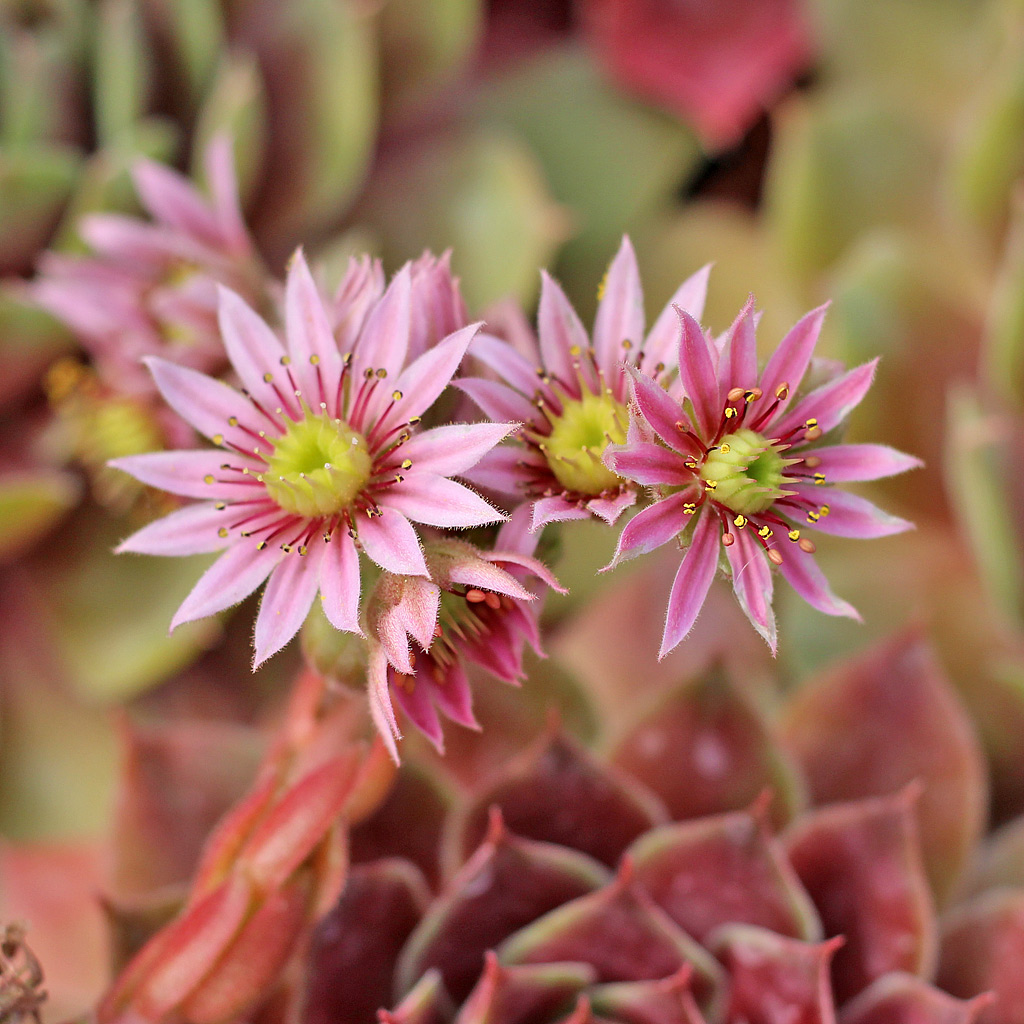Care Guides
Sempervivum Blooms: A Visual Guide
Sempervivum (Hens and Chicks) and Sempervivum heuffelii are resilient perennial succulents that make striking outdoor plantings. But just like an Agave century plant that send up a spike and goes to seed, a flowering semp rosette is at the end of its life. Below, we'll show you the ways to manage blooming Sempervivum and keep your succulents alive longer.

|
| Flowers of Sempervivum 'Fame' |
What happens when a Sempervivum blooms?
Semps can produce vegetative offsets (chicks) every year, so they do not need to flower to reproduce new seedlings annually. They are, however, a monocarpic plant, meaning that any rosette that does flower and go to seed will die. Think of it as the plant's swan song at the end of its life as it makes way for a new generation.
Hens & Chicks are not typical grown for their flowers, but the blooms are small and come in shades of white, yellow, or pink. If your intention is to hybridize or grow Sempervivum from seed, then blooms are a welcome sight, but for many gardeners, flowering is cause to worry. Dead rosettes leave gaps in otherwise tidy Sempervivum clumps and a solitary, flowering mother hen with no chick offsets will be the last of her colony.

|
| Lone, blooming Sempervivum 'Kip' |
What triggers a rosette to go to seed?
Flowering is an unpredictable process in Sempervivum. One year there'll be none, and in another, a whole colony can bolt to produce seeds. It's hard to know exactly what is signaling to the plants that the end is near and they need to propagate, because any form of stress can induce flowering. Drastic changes in light, temperature, and water can threaten a rosette's survival and thus make it divert its resources into producing the next generation of seedlings.
All Sempervivum will eventually bloom after several years of growth, whether induced by stress or simply age. Signs that a rosette is preparing to flower include a closing in of the central leaves, stretching of the main stem, and tilting of the whole rosette.

|
|
Sempervivum 'Red Wings' preparing to bloom |
How do you prevent blooming?
You can minimize stress to reduce the incidence of blooming, but all rosettes will eventually bloom regardless. When this happens, you need to remove the bloom stalk as soon as it is noticeable. If you catch it too late, the stem will be tougher and the hormones that initiate flowering will already be at work. From our experience, the success of preventing flowering is highest when the bloom stalk is less than four inches tall.
Proceed confidently through the following surgical steps, knowing that an untreated rosette will certainly die and you've got nothing to lose.
- Separate the tighter, upturned leaves of the developing bloom from the low-lying layers of leaves at the base of the rosette.
- Using a sharp, clean knife, scoop the bloom stalk out from the rosette.
- Continue your normal schedule of watering and care while checking weekly for new growth.

Results
This procedure is your last chance to get new chicks from a blooming Sempervivum rosette. It will not return you to the single, perfectly symmetrical mother hen you started with, but it can give you more offsets to transplant. Even if you follow this guide perfectly, some rosettes will keep trying to flower. You can continue to remove new bloom stalks, but be sure not to confuse them with emerging chicks. If you spot new offsets forming within the rosette, congratulations! You have successfully saved the rosette. If not, any non-flowering rosettes in the surrounding colony will survive and grow to fill the gap left by the one that went to seed and died.
   
|
| From top to bottom: Sempevivum 'Starshine' preparing to bloom; recently cut rosette; one month after treatment with offsets forming; new offsets two months after treatment. |
Remember:
- Sempervivum can take years to bloom, but a flowering rosette will die if it goes to seed.
- Look for signs of elongation to catch a bloom stalk as soon as it begins to form.
- Use a sharp, clean knife to cut out the tighter leaves on the developing bloom stalk.
- Continue to cut out flowers and watch for offsets that you can cultivate or transplant.
We wish you all the best in your efforts to recover blooming Sempervivum rosettes. If all else fails, there's alway the next batch of chicks!

|
| Blooming semps happen to everyone |
